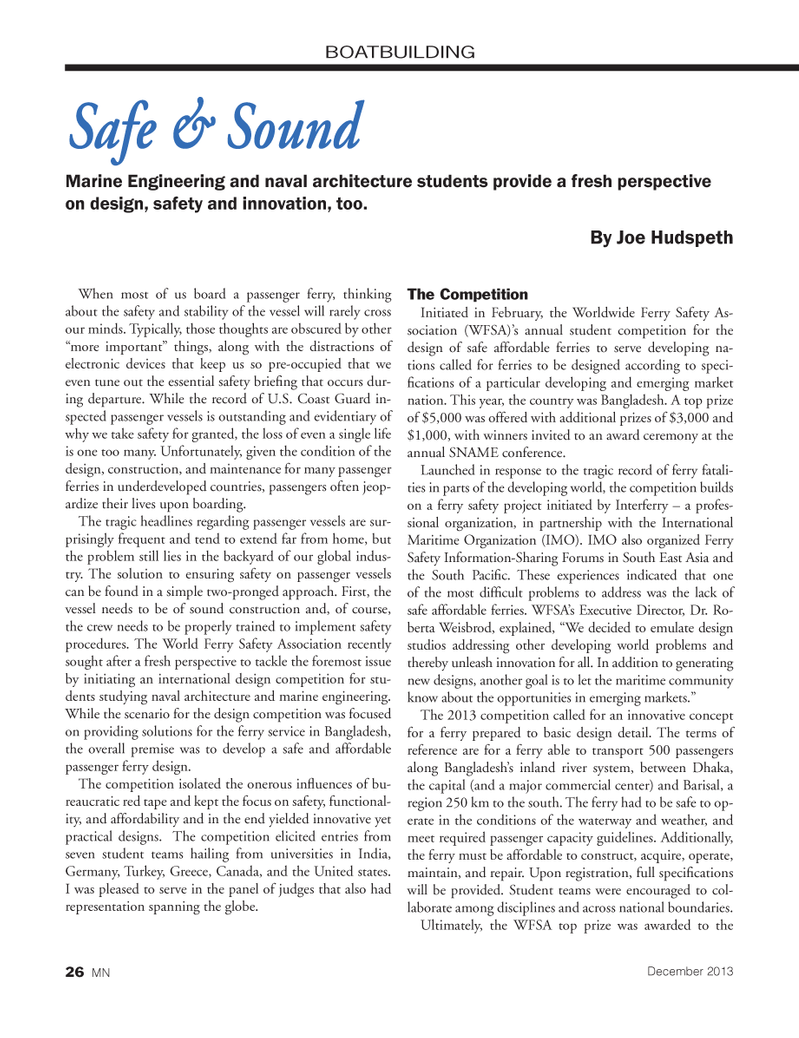
Page 26: of Marine News Magazine (December 2013)
Innovative Products & Boats of 2012
Read this page in Pdf, Flash or Html5 edition of December 2013 Marine News Magazine
When most of us board a passenger ferry, thinking about the safety and stability of the vessel will rarely cross our minds. Typically, those thoughts are obscured by other ?more important? things, along with the distractions of electronic devices that keep us so pre-occupied that we even tune out the essential safety brie ng that occurs dur-ing departure. While the record of U.S. Coast Guard in- spected passenger vessels is outstanding and evidentiary of why we take safety for granted, the loss of even a single life is one too many. Unfortunately, given the condition of the design, construction, and maintenance for many passenger ferries in underdeveloped countries, passengers often jeop- ardize their lives upon boarding. The tragic headlines regarding passenger vessels are sur- prisingly frequent and tend to extend far from home, but the problem still lies in the backyard of our global indus- try. The solution to ensuring safety on passenger vessels can be found in a simple two-pronged approach. First, the vessel needs to be of sound construction and, of course, the crew needs to be properly trained to implement safety procedures. The World Ferry Safety Association recently sought after a fresh perspective to tackle the foremost issue by initiating an international design competition for stu- dents studying naval architecture and marine engineering. While the scenario for the design competition was focused on providing solutions for the ferry service in Bangladesh, the overall premise was to develop a safe and affordable passenger ferry design. The competition isolated the onerous in uences of bu- reaucratic red tape and kept the focus on safety, functional- ity, and affordability and in the end yielded innovative yet practical designs. The competition elicited entries from seven student teams hailing from universities in India, Germany, Turkey, Greece, Canada, and the United states. I was pleased to serve in the panel of judges that also had representation spanning the globe. The CompetitionInitiated in February, the Worldwide Ferry Safety As- sociation (WFSA)?s annual student competition for the design of safe affordable ferries to serve developing na- tions called for ferries to be designed according to speci- cations of a particular developing and emerging market nation. This year, the country was Bangladesh. A top prize of $5,000 was offered with additional prizes of $3,000 and $1,000, with winners invited to an award ceremony at the annual SNAME conference. Launched in response to the tragic record of ferry fatali- ties in parts of the developing world, the competition builds on a ferry safety project initiated by Interferry ? a profes- sional organization, in partnership with the International Maritime Organization (IMO). IMO also organized Ferry Safety Information-Sharing Forums in South East Asia and the South Paci c. These experiences indicated that one of the most dif cult problems to address was the lack of safe affordable ferries. WFSA?s Executive Director, Dr. Ro- berta Weisbrod, explained, ?We decided to emulate design studios addressing other developing world problems and thereby unleash innovation for all. In addition to generating new designs, another goal is to let the maritime community know about the opportunities in emerging markets.? The 2013 competition called for an innovative concept for a ferry prepared to basic design detail. The terms of reference are for a ferry able to transport 500 passengers along Bangladesh?s inland river system, between Dhaka, the capital (and a major commercial center) and Barisal, a region 250 km to the south. The ferry had to be safe to op- erate in the conditions of the waterway and weather, and meet required passenger capacity guidelines. Additionally, the ferry must be affordable to construct, acquire, operate, maintain, and repair. Upon registration, full speci cations will be provided. Student teams were encouraged to col- laborate among disciplines and across national boundaries. Ultimately, the WFSA top prize was awarded to the BOATBUILDING Safe & Sound Safe & Sound Marine Engineering and naval architecture students provide a fresh perspective on design, safety and innovation, too. By Joe Hudspeth26 MNDecember 2013MN Dec2013 Layout 18-31.indd 26MN Dec2013 Layout 18-31.indd 2611/25/2013 12:45:43 PM11/25/2013 12:45:43 PM

 25
25

 27
27
